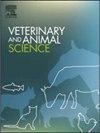Development of duplex crystal digital PCR (dPCR) assay for detection and differentiation of NDRV and MDRV
IF 1.9
Q2 AGRICULTURE, DAIRY & ANIMAL SCIENCE
引用次数: 0
Abstract
Muscovy duck reovirus (MDRV) and Novel duck reovirus (NDRV) are highly infectious diseases of waterfowl, causing significant harm to the global poultry industry. Early detection and diagnosis of NDRV and MDRV in clinical samples are crucial for effectively preventing and controlling these diseases. This study developed a duplex crystal digital PCR (dPCR) assay for the differential detection of NDRV and MDRV. Primer pairs and probes were designed specifically for the S3 genome of NDRV and the S2 genome of MDRV. To evaluate the method's performance, different reaction conditions were optimized, focusing on specificity, sensitivity, and reproducibility. The results showed that duplex crystal dPCR could accurately and differentially detect NDRV and MDRV, with a detection limit as low as 1 × 10⁻¹ copies/μl. It did not cross-react with other avian viruses, including duck Tembusu virus (DTMUV), H5 subtype avian influenza virus (H5 subtype AIV), H7 subtype AIV, H9 subtype AIV, Newcastle disease virus (NDV), infectious bronchitis virus (IBV), Egg drop syndrome virus (EDSV), Contagious bursal disease virus (IBDV, B87 strain), and duck Plague virus (DEV). The method also demonstrated good reproducibility, with intra-assay and inter-assay coefficients of variation (CV) both less than 8 %. For clinical application, 299 samples from coastal areas of Guangxi, China were tested. Duplex crystal dPCR detected NDRV and MDRV positive rates of 8.027 % and 6.020 %, respectively, with a co-infection rate of 1.672 %. The kappa values between duplex crystal dPCR and duplex quantitative polymerase chain reaction (qPCR) were 0.977 for NDRV and 1 for MDRV, indicating strong agreement. These findings confirm that the established duplex crystal dPCR is a specific, sensitive, and accurate method for detecting and quantifying NDRV and MDRV. This is the first report of using duplex crystal dPCR for NDRV and MDRV detection.
建立NDRV和MDRV双晶数字PCR (dPCR)检测和鉴别方法
番鸭呼肠孤病毒(MDRV)和新型鸭呼肠孤病毒(NDRV)是水禽的高传染性疾病,对全球家禽业造成重大危害。临床样本中NDRV和MDRV的早期发现和诊断对于有效预防和控制这些疾病至关重要。本研究建立了NDRV和MDRV的双晶数字PCR (dPCR)鉴别检测方法。分别为NDRV S3基因组和MDRV S2基因组设计了引物对和探针。为了评价该方法的性能,优化了不同的反应条件,重点考察了特异性、敏感性和重现性。结果表明,双晶dPCR能准确鉴别NDRV和MDRV,检出限低至1 × 10⁻¹拷贝/μl。与鸭坦布苏病毒(DTMUV)、H5亚型禽流感病毒(H5亚型AIV)、H7亚型AIV、H9亚型AIV、新城疫病毒(NDV)、传染性支气管炎病毒(IBV)、降蛋综合征病毒(EDSV)、传染性法氏囊病病毒(IBDV, B87株)、鸭鼠疫病毒(DEV)等禽类病毒无交叉反应。该方法重现性好,测定内变异系数和测定间变异系数均小于8%。为临床应用,对来自中国广西沿海地区的299份样本进行了检测。双晶dPCR检测NDRV和MDRV阳性率分别为8.027%和6.020%,共感染率为1.672%。双晶dPCR与双晶定量聚合酶链反应(qPCR)的kappa值分别为0.977和1,两者吻合较好。这些结果证实了所建立的双晶dPCR是一种特异、灵敏、准确的检测和定量NDRV和MDRV的方法。这是首次用双晶dPCR检测NDRV和MDRV。
本文章由计算机程序翻译,如有差异,请以英文原文为准。
求助全文
约1分钟内获得全文
求助全文
来源期刊

Veterinary and Animal Science
Veterinary-Veterinary (all)
CiteScore
3.50
自引率
0.00%
发文量
43
审稿时长
47 days
 求助内容:
求助内容: 应助结果提醒方式:
应助结果提醒方式:


